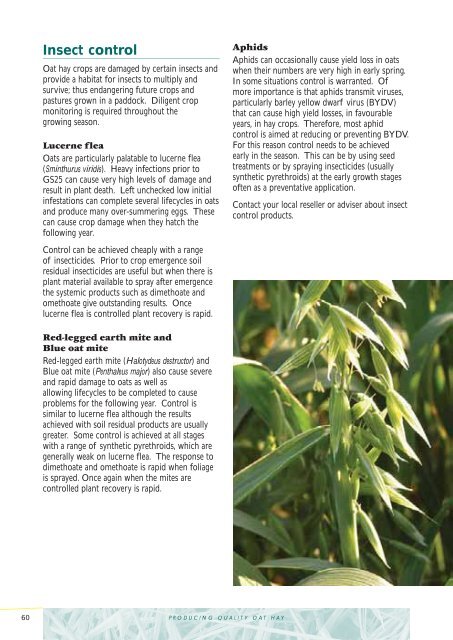You also want an ePaper? Increase the reach of your titles
YUMPU automatically turns print PDFs into web optimized ePapers that Google loves.
Insect control<br />
<strong>Oat</strong> hay crops are damaged by certain insects and<br />
provide a habitat for insects to multiply and<br />
survive; thus endangering future crops and<br />
pastures grown in a paddock. Diligent crop<br />
monitoring is required throughout the<br />
growing season.<br />
Lucerne flea<br />
<strong>Oat</strong>s are particularly palatable to lucerne flea<br />
(Sminthurus viridis). Heavy infections prior to<br />
GS25 can cause very high levels of damage and<br />
result in plant death. Left unchecked low initial<br />
infestations can complete several lifecycles in oats<br />
and produce many over-summering eggs. These<br />
can cause crop damage when they hatch the<br />
following year.<br />
Control can be achieved cheaply with a range<br />
of insecticides. Prior to crop emergence soil<br />
residual insecticides are useful but when there is<br />
plant material available to spray after emergence<br />
the systemic products such as dimethoate and<br />
omethoate give outstanding results. Once<br />
lucerne flea is controlled plant recovery is rapid.<br />
Red-legged earth mite and<br />
Blue oat mite<br />
Red-legged earth mite (Halotydeus destructor) and<br />
Blue oat mite (Penthaleus major) also cause severe<br />
and rapid damage to oats as well as<br />
allowing lifecycles to be completed to cause<br />
problems for the following year. Control is<br />
similar to lucerne flea although the results<br />
achieved with soil residual products are usually<br />
greater. Some control is achieved at all stages<br />
with a range of synthetic pyrethroids, which are<br />
generally weak on lucerne flea. The response to<br />
dimethoate and omethoate is rapid when foliage<br />
is sprayed. Once again when the mites are<br />
controlled plant recovery is rapid.<br />
60 PRODUCING QUALITY OAT HAY<br />
Aphids<br />
Aphids can occasionally cause yield loss in oats<br />
when their numbers are very high in early spring.<br />
In some situations control is warranted. Of<br />
more importance is that aphids transmit viruses,<br />
particularly barley yellow dwarf virus (BYDV)<br />
that can cause high yield losses, in favourable<br />
years, in hay crops. Therefore, most aphid<br />
control is aimed at reducing or preventing BYDV.<br />
For this reason control needs to be achieved<br />
early in the season. This can be by using seed<br />
treatments or by spraying insecticides (usually<br />
synthetic pyrethroids) at the early growth stages<br />
often as a preventative application.<br />
Contact your local reseller or adviser about insect<br />
control products.

















